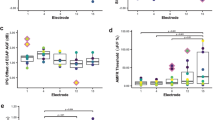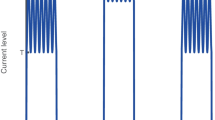Abstract
The stimulation rate in cochlear implant (CI) sound coding, or the “carrier” rate in pulses per second (pps), is known to influence pitch perception, as well as loudness perception and sound quality. Our main objective was to investigate the effects of reduced carrier rate on the loudness and pitch of coded speech samples. We describe two experiments with 16 Nucleus® CI users, where we controlled modulation characteristics and carrier rate using Spectral and Temporal Enhanced Processing (STEP), a novel experimental multichannel sound coder. We used a fixed set of threshold and comfortable stimulation levels for each subject, obtained from clinical MAPs. In the first experiment, we determined equivalence for voice pitch ranking and voice gender categorization between the Advanced Combination Encoder (ACE), a widely used clinical strategy in Nucleus® recipients, and STEP for fundamental frequencies (F0) 120–250 Hz. In the second experiment, loudness was determined as a function of the input amplitude of speech samples for carrier rates of 1000, 500, and 250 pps per channel. Then, using equally loud sound coder programs, we evaluated the effect of carrier rate on voice pitch perception. Although nearly all subjects could categorize voice gender significantly above chance, pitch ranking varied across subjects. Overall, carrier rate did not substantially affect voice pitch ranking or voice gender categorization: as long as the carrier rate was at least twice the fundamental frequency, or when stimulation pulses for the lowest, 250 pps carrier were aligned to F0 peaks. These results indicate that carrier rates as low as 250 pps per channel are sufficient to support functional voice pitch perception for those CI users sensitive to temporal pitch cues; at least when temporal modulations and pulse timings in the coder output are well controlled by novel strategies such as STEP.








Similar content being viewed by others
References
Arora K, Dawson P, Dowell R, Vandali A (2009) Electrical stimulation rate effects on speech perception in cochlear implants. Int J Audiol 48:561–567. https://doi.org/10.1080/14992020902858967
Arora K, Vandali A, Dowell R, Dawson P (2011) Effects of stimulation rate on modulation detection and speech recognition by cochlear implant users. Int J Audiol 50:123–132. https://doi.org/10.3109/14992027.2010.527860
Brochier T, McDermott HJ, McKay CM (2017) The effect of presentation level and stimulation rate on speech perception and modulation detection for cochlear implant users. J Acoust Soc Am 141:4097–4105. https://doi.org/10.1121/1.4983658
Carlyon RP, van Wieringen A, Long CJ et al (2002) Temporal pitch mechanisms in acoustic and electric hearing. J Acoust Soc Am 112:621. https://doi.org/10.1121/1.1488660
Chatterjee M, Oberzut C (2011) Detection and rate discrimination of amplitude modulation in electrical hearing. J Acoust Soc Am 130:1567–1580. https://doi.org/10.1121/1.3621445
Francart T, Osses A, Wouters J (2015) Speech perception with F0mod, a cochlear implant pitch coding strategy. Int J Audiol 54:424–432. https://doi.org/10.3109/14992027.2014.989455
Fraser M, McKay CM (2012) Temporal modulation transfer functions in cochlear implantees using a method that limits overall loudness cues. Hear Res 283:59–69. https://doi.org/10.1016/j.heares.2011.11.009
Galvin JJ, Fu Q-J (2009) Influence of stimulation rate and loudness growth on modulation detection and intensity discrimination in cochlear implant users. Hear Res 250:46–54. https://doi.org/10.1016/j.heares.2009.01.009
Galvin JJ, Fu Q-J, Oba S, Başkent D (2014) A method to dynamically control unwanted loudness cues when measuring amplitude modulation detection in cochlear implant users. J Neurosci Methods 222:207–212. https://doi.org/10.1016/j.jneumeth.2013.10.016
Green T, Faulkner A, Rosen S (2012) Variations in carrier pulse rate and the perception of amplitude modulation in cochlear implant users. Ear Hear 33:221–230. https://doi.org/10.1097/AUD.0b013e318230fff8
Green T, Faulkner A, Rosen S, Macherey O (2005) Enhancement of temporal periodicity cues in cochlear implants: effects on prosodic perception and vowel identification. J Acoust Soc Am 118:375–385
Hughes ML, Baudhuin JL, Goehring JL (2014) The relation between auditory-nerve temporal responses and perceptual rate integration in cochlear implants. Hear Res 316:44–56. https://doi.org/10.1016/j.heares.2014.07.007
James CJ, Skinner MW, Martin LFA et al (2003) An investigation of input level range for the nucleus 24 cochlear implant system: speech perception performance, program preference, and loudness comfort ratings. Ear Hear 24:157–174. https://doi.org/10.1097/01.AUD.0000058107.64929.D6
Kong Y-Y, Carlyon RP (2010) Temporal pitch perception at high rates in cochlear implants. J Acoust Soc Am 127:3114–3123. https://doi.org/10.1121/1.3372713
Kong Y-Y, Deeks JM, Axon PR, Carlyon RP (2009) Limits of temporal pitch in cochlear implants. J Acoust Soc Am 125:1649–1657. https://doi.org/10.1121/1.3068457
Kovačić D, Balaban E (2009) Voice gender perception by cochlear implantees. J Acoust Soc Am 126:762–775. https://doi.org/10.1121/1.3158855
Lamping W, Deeks JM, Marozeau J, Carlyon RP (2020) The effect of phantom stimulation and pseudomonophasic pulse shapes on pitch perception by cochlear implant listeners. JARO 21:511–526. https://doi.org/10.1007/s10162-020-00768-x
Laneau J, Wouters J, Moonen M (2006) Improved music perception with explicit pitch coding in cochlear implants. Audiol Neurootol 11:38–52. https://doi.org/10.1159/000088853
Massida Z, Marx M, Belin P et al (2013) Gender categorization in cochlear implant users. J Speech Language Hear Res: JSLHR 56:1389–1401. https://doi.org/10.1044/1092-4388(2013/12-0132)
McKay CM, McDermott HJ, Clark GM (1994) Pitch percepts associated with amplitude-modulated current pulse trains in cochlear implantees. J Acoust Soc Am 96:2664–2673. https://doi.org/10.1121/1.411377
Meister H, Fürsen K, Streicher B et al (2016) The use of voice cues for speaker gender recognition in cochlear implant recipients. J Speech Lang Hear Res 59:546. https://doi.org/10.1044/2015_JSLHR-H-15-0128
Milczynski M, Wouters J, van Wieringen A (2009) Improved fundamental frequency coding in cochlear implant signal processing. J Acoust Soc Am 125:2260–2271. https://doi.org/10.1121/1.3085642
Pfingst BE, Colesa DJ, Hembrador S et al (2011) Detection of pulse trains in the electrically stimulated cochlea: effects of cochlear health. J Acoust Soc Am 130:3954–3968. https://doi.org/10.1121/1.3651820
R Core Team (2020) R: a language and environment for statistical computing. R Foundation for Statistical Computing, Vienna, Austria
Skinner MW, Holden LK, Holden TA, Demorest ME (1995) Comparison of procedures for obtaining thresholds and maximum acceptable loudness levels with the nucleus cochlear implant system. J Speech Lang Hear Res 38:677–689. https://doi.org/10.1044/jshr.3803.677
Smith DRR, Walters TC, Patterson RD (2007) Discrimination of speaker sex and size when glottal-pulse rate and vocal-tract length are controlled. J Acoust Soc Am 122:3628–3639. https://doi.org/10.1121/1.2799507
Smith ZM, Kan A, Jones HG et al (2014) Hearing better with interaural time differences and bilateral cochlear implants. J Acoust Soc Am 135:2190–2191. https://doi.org/10.1121/1.4877139
Todd AE, Goupell MJ, Litovsky RY (2019) Binaural unmasking with temporal envelope and fine structure in listeners with cochlear implants. J Acoust Soc Am 145:2982–2993. https://doi.org/10.1121/1.5102158
Vandali A, van Hoesel RJM (2012) Enhancement of temporal cues to pitch in cochlear implants: effects on pitch ranking. J Acoust Soc Am 132:392–402. https://doi.org/10.1121/1.4718452
Vandali AE, Dawson PW, Arora K (2017) Results using the OPAL strategy in Mandarin speaking cochlear implant recipients. Int J Audiol 56:S74–S85. https://doi.org/10.1080/14992027.2016.1190872
Vandali AE, Sucher C, Tsang DJ et al (2005) Pitch ranking ability of cochlear implant recipients: a comparison of sound-processing strategies. J Acoust Soc Am 117:3126–3138. https://doi.org/10.1121/1.1874632
Vandali AE, Whitford LA, Plant KL, Clark GM (2000) Speech perception as a function of electrical stimulation rate: using the nucleus 24 cochlear implant system: Ear Hear 21:608–624. https://doi.org/10.1097/00003446-200012000-00008
Zhou N, Xu L, Pfingst BE (2012) Characteristics of detection thresholds and maximum comfortable loudness levels as a function of pulse rate in human cochlear implant users. Hear Res 284:25–32. https://doi.org/10.1016/j.heares.2011.12.008
ACKNOWLEDGEMENTS
The authors would like to thank Dr. Boška Munivrana Dervišbegović from the SUVAG Polyclinic and Danijel Nejašmić for the assistance in data collection from the CI subjects, and Tonći Kozina for the technical and programming assistance.
Funding
This study was supported by the Investigator-Initiated Research (IIR) Grants #2098 and #853 from Cochlear© awarded to DK. Besides, DK was also partially supported by the EU structural grant for Croatia (code: HR.3.2.01–0320) and Split-Dalmatia County.
Author information
Authors and Affiliations
Corresponding author
Ethics declarations
Ethics Approval and Consent to Participate
The study was approved by the ethical committee of the SUVAG Polyclinic (# 510–08/17–20). Either CI subject or one of their parents gave written informed consent, depending on the subjects’ age.
Additional information
Publisher's Note
Springer Nature remains neutral with regard to jurisdictional claims in published maps and institutional affiliations.
Rights and permissions
About this article
Cite this article
Kovačić, D., James, C.J. Stimulation Rate and Voice Pitch Perception in Cochlear Implants. JARO 23, 665–680 (2022). https://doi.org/10.1007/s10162-022-00854-2
Received:
Accepted:
Published:
Issue Date:
DOI: https://doi.org/10.1007/s10162-022-00854-2




